Rajasthan Board RBSE Class 12 Chemistry Chapter 1 Solid State
RBSE Class 12 Chemistry Chapter 1 Text Book Questions
RBSE Class 12 Chemistry Chapter 1 Multiple Choice Questions
RBSE Solutions For Class 12 Chemistry Chapter 1 Question 1.
The number of atoms in body centred cubic arrangement is-
(a) 1
(b) 2
(c) 4
(d) 6
RBSE Class 12 Chemistry Chapter 1 Question 2.
A compound is formed by the crystallisation of A and B in cubic close packing where atom A is arranged at the corners of cube and atom B are arranged at the center of each faces. The formula of compounds is-
(a) AB
(b) A2B
(c) AB2
(d) A2B3
Chemistry Class 12 Chapter 1 RBSE Question 3.
Which of the following is not an example of 13–15 compounds?
(a) InSb
(b) GaAS
(c) CdSe
(d) AIP
RBSE 12th Chemistry Chapter 1 Question 4.
The total number of atoms in unit cell of hexagonal close packing is?
(a) 4
(b) 6
(c) 8
(d) 12
RBSE Solutions For Class 12 Chemistry Question 5.
Which of the following anion has higher co-ordination number?
(a) NaCl
(b) ZnS
(c) CaF2
(d) Na2O
Chemistry Class 12 RBSE Solutions Question 6.
Schottky defect is found
(a) when unequal number of cations and anions left its lattice site
(b) when equal number of cations and anions left – its lattice site
(c) when one ion left its lattice site and occupy interstitial site
(d) density of crystal increases
RBSE Class 12 Chemistry Chapter 1 Solution Question 7.
A p-type compound is electrically
(a) positive
(b) negative
(c) neutral
(d) depends upon the concentration of p-impuriy
RBSE Solution Class 12th Chemistry Question 8.
Which of the following cation has co-ordination number 8?
(a) Cscl
(b) ZnS
(c) NaCl
(d) Na2O
RBSE Solution Class 12 Chemistry Question 9.
Which of the following transition metal compounds is paramagnetic in nature?
(a) MnO
(b) NiO
(c) VO
(d) Mn2O3
RBSE Solutions Class 12 Chemistry Question 10.
The number of tetrahedral and octahedral voids in a hexagonal primitive unit cell is-
(a) 8,4
(b) 6,6
(c) 2,1
(d) 12,6
Answers:
1. (b), 2. (b), 3. (c), 4. (b), 5. (d), 6. (b), 7. (c), 8. (a), 9. (c), 10. (d)
RBSE Class 12 Chemistry Chapter 1 Very Short Answer Type Questions
Class 12 Chemistry RBSE Solutions Question 1.
Why solids are hard?
Answer:
In solids the positions of constituent particles like atoms or molecules or ions are fixed i.e., they are not free to move. They are stationary in their fixed position. They have strong intermolecular or interionic forces of attraction. Hence solids are hard.
RBSE Solutions Chemistry Class 12 Question 2.
Why do solids have a definite volume?
Answer:
The constituent particles of solid like atoms or molecules or ions have fixed positions and are not free to move about i.e., they are rigid. That is why they have a definite volume.
RBSE Solutions For Class 12 Chemistry Chapter 1 Question 3.
Solid A is very hard, electrical insulator is solid as well as in molten state of extremely high temperature. What type of solid is it?
Answer:
Covalent or network solids like SiO2, (quartz) or SiC or C (diamond).
RBSE Class 12 Chemistry Chapter 1 Notes Question 4.
Which type of solids are conductors of electricity, malleable and ductile?
Answer:
Metallic solids are conductors of electricity, malleable and ductile.
RBSE Solutions For Class 12 Chemistry Chapter 1 Question 5.
What do you understand by ‘lattice point’ ?
Answer:
Each lattice point represents one constituent particle of solid. This constituent particle may be an atom, a molecule (group of atoms) or an ion.
Chemistry RBSE Solutions Class 12 Question 6.
Name the parameters which are characterize a unit cell.
Answer:
A unit cell is characterized by the following six parameters:
(i) The dimensions of the unit cell along three edges. They may be or may not be perpendicular.
(ii) The angles between the edges. These are represented by αß and y. a (between b and c), ß between a and c), 7 (between a and b).
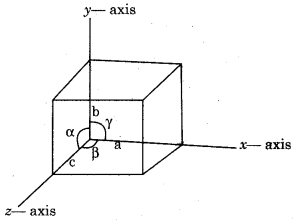
Chemistry Class 12 Chapter 1 Question 7.
What is the two-dimensional coordination number in square close packed layer?
Answer:
In square close packing , each atom is in contact with four neighbouring atoms, so its coordination number is 4.
Class 12th Chemistry RBSE Solutions Question 8.
Which of the following lattice has the highest packing efficiency ?
(1) Simple cubic
(2) Body centred cube and
(3) Hexagonal close packing lattice
Answer:
The packing efficiency in lattice is as follows:
(1) Simple cubic = 52.4%
(2) Body-centred cubic = 68%
(3)Hexagonal close packing = 74%.
Hence the maximum packing efficiency is of hexagonal packing lattice .
RBSE Solutions 12 Chemistry Question 9.
Describe the term “amorphous’. Give a few examples of amorphous solids.
Answer:
Amorphous solids are those solids in which the constituent particles may have a short range order, have irregular shape and isotropic in nature. They do not show clean cleavage. They do not have sharp melting points and do not have definite heat of fusion.
Examples: glass, plastics and rubber etc.
RBSE Class 12 Chemistry Chapter 1 Short Answer Type Questions
RBSE Solutions For Class 12th Chemistry Question 1.
Classify the following as amorphous and crystalline solids:
Polyurethane, naphthalene, benzoic acid, teflon, potassium nitrate, cellophane, polyvinyl chloride, fibre
glass, copper.
Answer:
Amorphous solids-Polyurethane, Teflon, Cellophane, Polyvinyl chloride, Fibre glass. Crystalline solids-Naphthalene, Benzoic acid, Potassium nitrate and Copper.
RBSE Solutions For Class 12 Chemistry Chapter 1 Question 2.
Why is glass considered a super-cooled liquid?
Answer:
Glass is an amorphous solid. Like liquid it has a tendency to flow, though very slowly. Because of its flowing nature the glass panes in the windows of old buildings are found to be slightly thicker at the bottom than at the top. Hence glass is consider as super-cooled liquid because of its flowing nature.
RBSE Solutions For Class 12 Chemistry In Hindi Question 3.
Refractive index of a solid is observed to have the same value along all directions. Comment on the nature of the solid. Would it show cleavage property ?
Answer:
As the solid have same values of refractive index among all directions, it means it is isotropic in nature. Hence, the solid is amorphous. As the solid is amorphous in nature so it would not show clean cleavage when cut with a knife. It would break in to pieces with irregular surfaces.
RBSE Class 12 Chemistry Chapter 1 In Hindi Question 4.
Classify the following solids into various categories on the basis of nature of inter molecular forces present in it: potassium sulphate, tin, benzene, urea, ammonia, water, zinc sulphide, graphite, rubidium, argon,
silicon carbide.
Answer:
Molecular solids-Benzene, urea, ammonia water, argon.
Ionic solids-Potassium sulphate, zinc sulphide.
Covalent or Network solids-Graphite, silicon carbide.
RBSE 12 Chemistry Solutions Question 5.
Ionic solids are conductor of electricity in fused state but not in solid state. Explain why.
Answer:
In molten or fused state, ionic solids dissociate to give free ions, hence can conduct electricity. In solid state, ions are not free to move as they are held together by strong electrostatic forces of attraction so cannot conduct electricity in solid state.
RBSE 12th Chemistry Solution Question 6.
A compound forms hexagonal close-packed structure. What is the total number of voids in 0.5 mol of it ? How many of these are tetrahedral voids?
Answer:
Number of atoms in 0.5 mole of compound
= 0.5 x 6.022 x 1023
= 3.011 x 1023
Number of octahedral voids =2 x Number of atoms in close packing
= 3011 x 1023
Number of terahedral voids = 2 x No. of atoms in close packing
= 2 x 3.011 x 1023
= 6.022 x 1023
Total number of voids = 3.011 x 1023 + 6.022 x 1023
= 9.033 x 1023
Solid State RBSE Pdf Question 7.
A compound is made up of two elements M and N. The element N forms ccp and atoms of M occupy \(\frac { 1 }{ 3 }\)rd of tetrahedral voids. What is the formula of compound?
Answer:
Let the atoms N in cep = x
No of tetrahedral voids = 2x
As \(\frac { 1 }{ 3 }\) rd of the tetrahedral voids are occupied by atoms M,
Hence, no. of atoms of M = \(\frac { 2x }{ 3 }\)
Ratio of M:N = 20 : \(\frac { 2x }{ 3 }\) = 2:3
Hence formula of compound is M2 N3
Solid State Chemistry Class 12 Question 8.
An element with molar mass 2.7 x 10-2 kg mol-1 forms a cubic unit cell with edge length 405 pm. Its density is 2.7 x 103 kg m-3. What is the nature of the cubic unit cell?
Answer:
Molar mass ‘M = 2.7 x 10-2 kg mol-1
Edge length ‘a’ = 405 pm
= 405 x 10-12m
= 4.05 x 10-10m
Density ‘d’ = 2.7 x 10-3kg m-3
Avogadro number ‘NA‘ = 6.022 x 1023
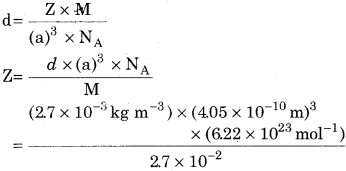
= 3.99 = 4
Thus there are 4 atoms of the element present per unit cell. Hence the cubic unit cell must be face centered or cubic close packed (ccp).
Class 12 Chemistry Chapter 1 Question 9.
What type of stoichiometric defect is shown by
(i) ZnS
(ii) Ag Br?
Answer:
(i) ZnS shows Frenkel defect.
(ii) AgBr shows both Frenkel as well as Schottky defects.
12th Chemistry RBSE Book Question 10.
Explain how vacancies are introduced in an ionic solid when a cation of higher valency is added as an impurity to it?
Answer:
Two or more cations of lower valency are replaced by a cation of higher valency to maintain electrical neutrality. Hence some cation vacancies are created. For example : In an ionic solid ‘NaCl’, if impurity of Sr2+ is added (as SrCl2) then two Na+ ions left thus lattice sites. To maintain electrical neutrality one lattice site is occupied by Sr2+ ion while other lattice site will remain vacant.
RBSE Class 12 Chemistry Solutions Question 11.
Ionic solids, which have anionic vacancies due to metal excess defect, develop colour. Explain with the help of a suitable example.
Answer:
When NaCl crystals are heated in the presence of sodium vapour some chloride ions left the lattice sites and combine with sodium to form NaCl. For this combination sodium atoms lose electrons to form Na+ ions. The released electrons diffuse into crystal to occupy the anion vacancies which are created by Cl– ions. In this condition the crystal have excess of sodium. The sites occupied by unpaired electrons are called F-centres or colour centres.
F-centre imparts yellow colour to NaCl crystal because they absorb energy from the visible light and get excited.
The Solid State Class 12 Question 12.
A group of 14 element is to be converted into n-type semiconductor by doping it with a suitable impurity. To which group should ‘this impurity belong?
Answer:
n-type semiconductor means conduction is due to the presence of excess of negatively charged electrons. Hence to convert the elements of 14-group into n-type semiconductor it should be doped with group-15 elements.
Solid State Class 12 Question 13.
What makes a glass different from a solid such as quartz? Under what conditions could quartz be converted into glass?
Answer:
Glass is an amorphous solid while quartz is crystalline solid. Glass has short range order while quartz has long rage order. On melting quartz and then cooling it rapidly, it is converted into glass.
Solid State Solutions Question 14.
Gold (atomic radius = 0.144 nm) crystallises in a face centred unit cell. What is the length of the side of the cell?
Answer:
For fcc,
Edge length of unit cell a = 2√2r
= 2 x 1.414 x 0.144 nm
= 0.407 nm
12th RBSE Chemistry Solution Question 15.
In terms of band theory, what is the difference
(i) between a conductor and an insulator?
(ii) between a conductor and a semiconductor?
Answer:
(i) Difference between conductor and insulator
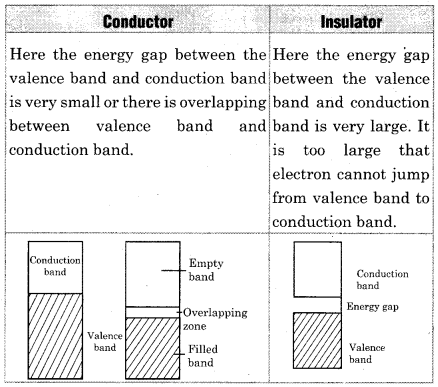
(ii) Difference between conductor and semiconductor
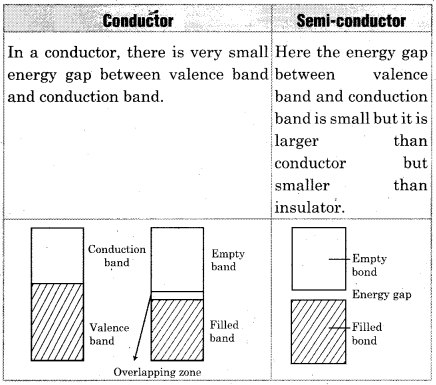
RBSE Class 12 Chemistry Notes Pdf Question 16.
Aluminium crystallises in a cubic close packed structure. Its metallic radius is 125pm.
(i) What is the length of the edge of the unit cell?
(ii) How many unit cells are there in 1.00 cm of aluminium?
Answer:
(i) ccp = fcc
For fcc, a = 2√2r
= 2 x 1.414 x 125 pm
= 353.5 pm
(ii) Volume of one unit cell = (a)3
= (3.535 x 10-8 cm) 3
= 442 x 10-25cm
442 x 10-25cm = Volume of one unit cell
![]()
= 2.26 x 1022 unit cells
RBSE Solution Chemistry Class 12 Question 17.
If NaCl is doped with 10-3 mol % SrCl2, what is the concentration of cation vacancies?
Answer:
NaCl is doped with 10-3 mol % of SrCl2
∴ In 100 part of NaCl = 10-3 mol SrCl2
1 part of NaCI = \(\frac { 10^{ -3 } }{ 100 }\) mol Srcl2
= 10-5 mol Srcl2
= 6.022 x 1023 x 10-5 Srcl2
= 6.022 x 1018 Srcl2
As each Sr2+ ion creates one void hence number of voids
= 6.022 x 1018
12th Class Agriculture Chemistry Book RBSE Question 18.
Classify the following solids as ionic, metallic molecular, covalent or amorphous :
(1) Tetraphosphorus decaoxide (P4O10)
(2) Ammonuim phosphate (NH4)3 PO4
(3) Plastic
(4) Graphite
(5) Brass
(6) SiC
(7) I2
(8) P4
(9) Rb
(10) Si
(11) LiBr
Answer:
Ionic solid – (NH4)3 PO4, LiBr
Metallic solid – Brass , Rb
Molecular solid – P4,O10, I2,P4
Covalent solid – Graphite , Sic , Si
Amorphous solid – Plastic
Chemistry Notes Class 12 RBSE In Hindi Question 19.
The stability of a crystal is reflected in the magnitude of its melting point”. Comment. Collect the value of melting point of water, ethyl alcohol, diethylether and methane from the data given in the book. What can you say about the inter molecular forces between these molecules?
Answer:
Higher the melting points, greater will be the forces of attraction between the molecules or constituent particles and hence greater will be the stability. The melting points of given compounds are as follows.
Water = 273 K
Ethyl alcohol = 155.7 K
Diethyl ether = 156.7K
Methane = 90.5 K
The inter molecular forces of attraction between the molecules of water and ethyl alcohol are mainly due to hydrogen bonding. The melting point of water is higher than ethyl alcohol shows that hydrogen bonding in ethyl alcohol molecules is not as strong as in water molecules. Diethyl ether is a polar molecule. The inter molecular forces present in them are dipole-dipole interactions Methane is a non-polar molecule. The only forces present in them are the weak vander waals forces i.e., London dispersion forces.
RBSE Chemistry Book Question 20.
How many lattice points are there in one unit cell of each of the following lattices.
(i) Face centred cubic?
(ii) Face centred tetragonal?
(iii) Body centred cubic?
Answer:
(i) Face centred cubic: Face centred cubic unit cell have total 14 lattice points. The number of atoms in fcc is 4.
8 (at corners) \(\frac { 1 }{ 8 }\)(atom per corner) + 6 (at the centre of face) x\(\frac { 1 }{ 2}\)
(atom per face)
= 8 x \(\frac { 1 }{ 8 }\) + 6 x \(\frac { 1 }{ 2}\) = 4
(atoms or constituent particles)
(ii) Face centred tetragonal:It also has 14 lattice points and the number of constituent particles is 4.
(iii) Body centred cubic-It has total 9 lattice points. The number of constituent particles is as follow:
8(at corners) x \(\frac { 1 }{ 8 }\)(atom per corner) +1 (centre of body) x 1 (atom per centre)
= 8 x \(\frac { 1 }{ 8 }\) = + 1
= 2 (atoms or constituent particls)
RBSE 12th Chemistry Important Questions With Answers Pdf Question 21.
Explain
(a) The basis of similarities and differences between metallic and ionic crystals.
(b) Ionic crystals are hard and brittle.
Answer:
(a) Similarities in metallic and ionic crystals
(i) Both i.e., metallic and ionic crystals have electrostatic forces of attraction. In ionic crystal these forces are in between cations and anions while in metallic crystals they are in between valence electrons and the kernels.
(ii) Both have high melting points
(iii) In both cases, the bond is non-directional
Differences between metallic and ionic crystals Metallic crystals
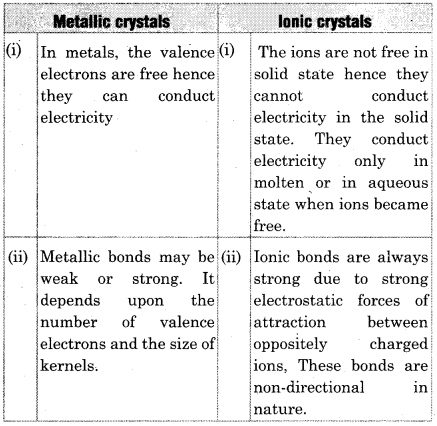
(b) Ionic crystals are hard because the strong electrostatic forces of attraction are present in between the oppositiely charged ions. They are brittle because ionic bonds are non-directional in nature.
RBSE Class 12th Chemistry Solution Question 22.
Silver crystallises in foc lattice. If the edge length of the cell is 4.07 x 10-8cm and density is 10.5g cm-3, then calculate the atomic mass of silver.
Answer:
In fcc lattice,
Z = 4
Edge length (a) = 4.07 x 10-8cm
Density (d) = 10.5 g/cm3
Avogadro number (NA) = 6.022 x 1023 mol-1
Atomic mass (M) = ?
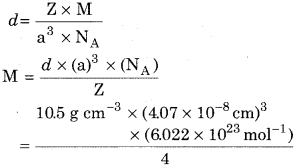
= 106.57gmol-1
12th Class Chemistry Book RBSE Question 23.
A cubic solid is made up of two elements P and Q. Atoms Q are present at the corners of the cube and atoms P at the body centre. What is the formula of the compound? What are the co-ordination number of P and Q?
Answer:
No. of atoms of ‘P’ at each unit cell = 1 x 1 = 1
No. of atoms of ‘Q’ present in each unit cell = 8 (at cornere) x \(\frac { 1 }{ 8}\)
Hence the formula of compound = PQ
The co-ordination number of each atom ‘P’ and ‘Q’ is 8.
Chemistry Book Class 12 RBSE Question 24.
Niobium crystallises in a body centred cubic
structure. If density is 8.55gcm-3, calculate atomic radius of niobium, given that its atomic mass is 93 u.
Answer:
For ‘bcc’ Z= 2
Denisty ‘d’= 8.55 g/cm3
Atomic mass ‘M’ = 93 u
Avogadro number ‘NA‘ = 6.022 x 1023mol-1
Atomic radius ‘r’ = ?
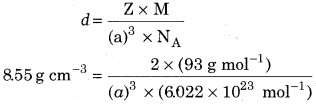
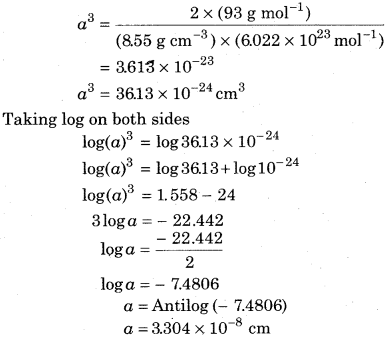
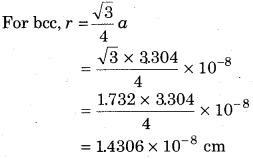
Radius of atom = 143.06 pm
Class 12 Chemistry Solutions RBSE Question 25.
Analysis shows that nickel oxide has the formula Ni0.98 O1.00. What fractions of the nickel exist as Ni2+ and Ni3+ions?
Answer:
Formula of nickel oxide = Ni0.98 O1.00
Let the no. of Ni2+ ions = x
Hence the charge on Ni2+ = + 2x
No. of Ni3+ions = 0.98 – x
Hence charge on Ni3+ions = + 3 [0.98 – x]
Total charge on oxide ions = – 2
Since the total charge on compound is zero hence,
+ 2x + 3 (0.98 – x) – 2 = 0
2x + 2.94 – 3x – 2 = 0
-x = -0.94
x = 0.94
Percentage of Ni2+ions = \(\frac { 0.94 }{ 0.94 } \times 100\) = 96%
Percentage of Ni2+ions = 100 – 96
= 4%
Class 12th RBSE Chemistry Solution Question 26.
Classify each of the following as being either a p-type or n-type semiconductor :
(i) Ge doped with In
(ii) Si doped with B.
Answer:
(i) Ge is related to group 14 of periodic table and In is the element of group 13. Hence when Ge is doped with In then an electron deficient hole is created. Hence it a p-type semiconductor.
(ii) Si is the element of group 14 while B is the element of group 13. When Si is doped with B, then an electron deficient hole is created so it is a ptype semiconductor.
RBSE Chemistry Solution Class 12 Question 27.
An element has a body-centred cubic (bcc) structure with cell edge of 288 pm. The density of the element is 7.2 g cm-3. How many atoms are present in 208 g of the element?
Answer:
For ‘bcc’ Z = 2
Edge length ‘a’ = 288 pm = 288 x 10-10 cm
Density (d) = 7.2 g cm-3, Mass of element = 208 g
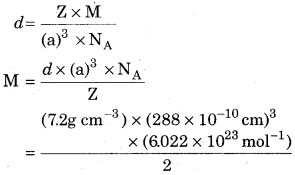
= 51.8 g mol-1
According to mol concept 51.8 g element has = 6.022 x 1023atoms
∴208 g of element will have = \(\frac { 208 }{ 51.8 } \times 6.022\) x 1023 atoms
= 24.17 x 1023 atoms
RBSE Class 12 Chemistry Book Solution Question 28.
X-ray diffraction studies show that copper crystallises in an fcc unit cell with cell edge of 3.608 x 108cm. In a separate experiment, copper is determined to have a density of 8.92g cm-3. Calculate the atomic mass of copper.
Answer:
Edge length ‘a’ = 3.608 x 10-8cm
Density (d) = 8.92g cm ,– 3
For fcc “Z’ = 4
Atomic mass ‘M’ = ?
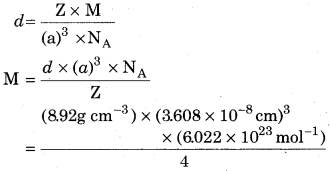
= 63.1 g mol-1
Hence the atomic mass of copper = 63.1g mol-1
RBSE Class 12 Chemistry Chapter 1 Long Answer Type Questions
Question 1.
How will you distinguish between the following pairs of terms
(i) Hexagonal and monoclinic unit cell
(ii) Face-centred and end – centred unit cell
Answer:
(i) Hexagonal and monoclinic unit cell
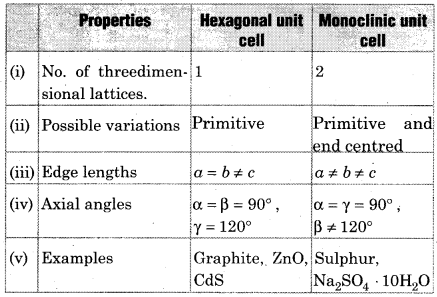
(ii) Face-centred and end-centred unit cell
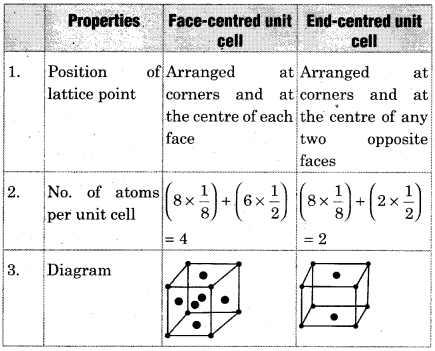
Question 2.
Explain how much portion of an atom at
(i)corner and
(ii) body centre of a cubic unit cell is part of its neighbouring unit cell.
Answer:
(i) In cubic unit cell, the atom present at corner is shared by eight simple cubic unit cells from which four are situated towards lower end and four are situated towards upper end. So actually only \(\frac { 1 }{ 8}\)
part of each constituent particle is related to specific unit cell.
(ii) The atom present at the centre of body do not shared any part of neighbouring atom, so the whole atom is present in unit cell.
Question 3.
What type of defect can arise when a solid is heated? Which physical property affected by it and in what way?
Answer:
When a solid is heated, vacancy defect is produced in the crystal. Because on heating. some atoms or ions leave the lattice sites completely i.e., some lattice sites become vacant. As a result of this defect, the density of the substance decreases because some atoms/ ions leave the crystal completely.
Question 4.
What type of substances would make better permanent magnets, ferromagnetic or ferrimagnetics. Justify your answer.
Answer:
Ferromagnetic substances make better permanent magnets because . metal ions of a ferromagnetic substance are grouped into a small region called ‘domains’. Each domain behaves like a small magnet. Here the domains are arranged randomly. When the substance is placed in magnetic field then these domains are oriented in the direction of magnetic field. As a result strong magnetic field is produced. The arragement of domains persists even in the absence of magnetic field. Hence, the ferromagnetic substance becomes a permanent magnet.
Question 5.
How can you determine the atomic mass of an unknown metal if you know its denisty and the dimensions of its unit cell? Explain your answer.
Answer:
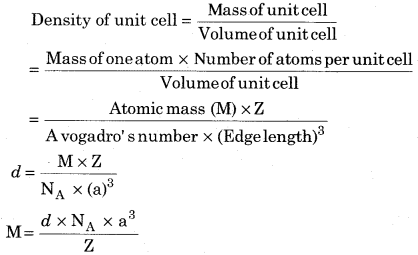
If we know the value of density of any unknown metal and dimensions of unit cell then with the help of above – formula we can calculate the atomic mass of that metal.
Question 6.
How will you distinguish between the following pairs of terms
(i) Hexagonal close packing and cubic close packing.
(ii) Crystal lattice and unit cell?
(iii) Tetrahedral.void and octahedral void?
Answer:
Difference between hexagonal close packing and cubic close packing
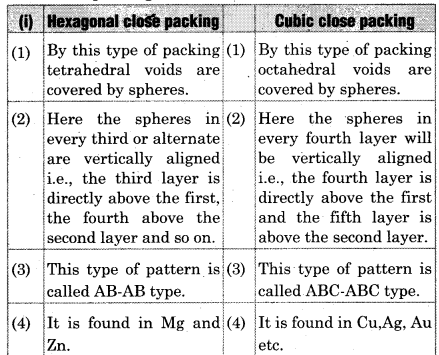
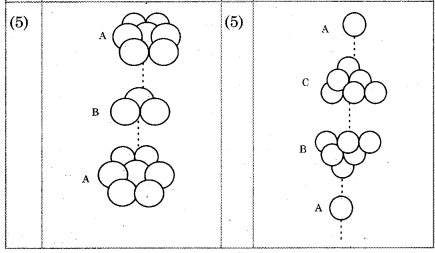
(ii) Differences between crystal lattice and unit cell Crystal lattice Unit cell
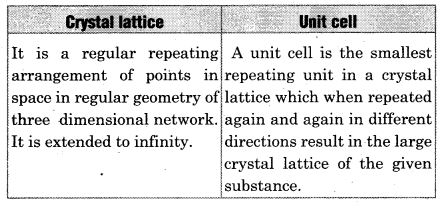
(iii) Differences between tetrahedral void and octahedral void Tetrahedral void Octahedral void

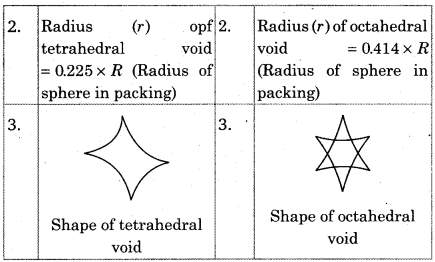
Question 7.
Calculate the efficiency of packing in case of a metal crystal for :
(i) Simple cubic
(ii) body centred cubic
(iii) Face centred cubic
Answer:
(i) Simple cubic
Radius of sphere = r
Edge length = a
As simple cubic structure is formed by one sphere hence,
the volume of one sphere = \(\frac { 4 }{ 3}\)πr3
As two spheres are touching each other hence,
a = 2 r

No. of spheres per unit cell = \(\frac { 1 }{ 8}\)= 1
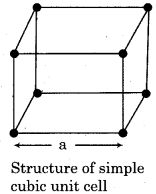
Volume of cube = (a)3= (2r)3 = 8r3

= 52.4%
(ii) Packing efficiency in body centred cubic structure (bcc) .
Radius of sphere = r.
Edge length = a
As bcc structure is formed by two spheres.
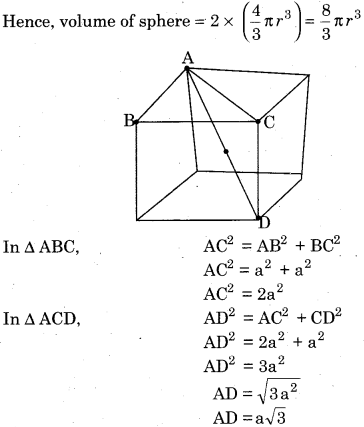
It we see the arrangement of spheres in AD then
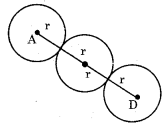
Put the value of AD in equation (i)
4r = a√3
a = \(\frac { 4r }{ \sqrt { 3 } } \)
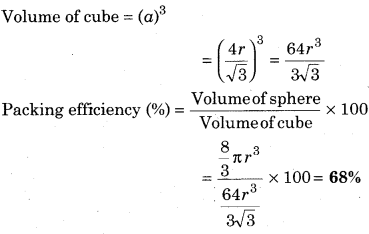
(iii) Packing efficiency in hcp or ccp or foc structure
Radius of sphere = r.
Edge length = a
Volume of one cube = \(\frac { 4 }{ 3}\)πr3
Since fcc is formed by 4 sphere, so the volume of four spheres = 4 x 4 \(\frac { 4 }{ 3}\)πr3
=\(\frac { 16 }{ 3}\)πr3
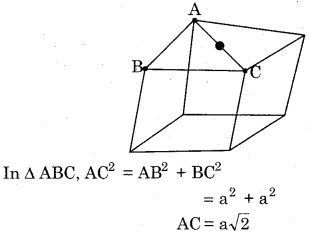
If we consider AC then.
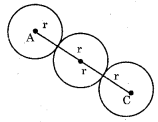
AC= 4r
Put the value of AC in eq (i).
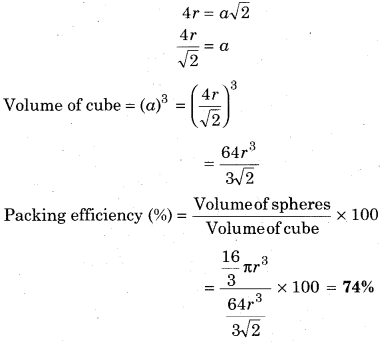
Question 8.
If the radius of the octahedral void is ‘r’ and the radius of the atom in the close packing is R. Derive the relationship between r and R.
Answer:
In the given structure, octahedral void is represented by sphere. The spheres present above and below the void are not shown in figure. Let the radius of sphere is ‘R’ while the radius of void is represented by ‘r”. Here edge length is ‘a’.
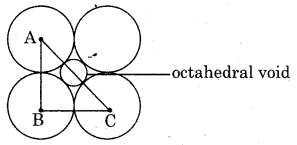
In the above given structure ABC is right angle triangle,
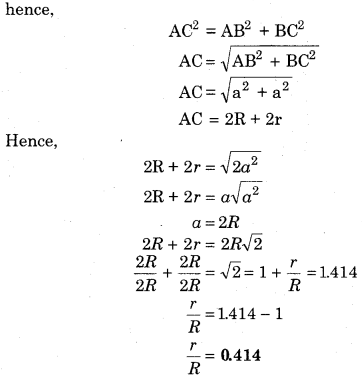
Question 9.
What is a ‘semiconductor”? Describe the main two types of semiconductors and contrast their conduction mechanisms.
Answer:
Substances whose conductance lies between that of metals (conductors) and insulators are called semiconductors. In these substances, the energy gap is small between valence band and conduction band. So some electrons are exited from valence band to the conduction band at normal temperature, therefore they show electrical conductivity but very low. On increasing temperature more electrons can go to conduction band, hence the conductivity of semiconductors increases with increase in temperature. Silicon and germanium show such behaviour hence they are called intrinsic semiconductors.
The conductivity of such substances can be increased by adding appropriate impurity in it. The process of addition of impurity to such substances for increasing conductivity, is called doping. By doping two types of semiconductors are formed which are as follow –
(1) n-type semiconductors
(2) p-type semiconductors
(1) n-type semiconductors:
This type of conductors are formed by the doping with electron rich impurities. Group 14 elements like silicon and germanium has 4 valence electrons in the valence shell. So they form four covalent bonds with the neighbouring atoms. When they are doped with group 15 elements like P or As, then some silicon or germanium atoms are substituted by them. As these atoms have 5 electrons in the valence shell, then after forming normal four covalent bonds with the neighbouring silicon atoms the fifth extra electron is free and get delocalised. These delocalised electrons increase the conductivity of silicon or germanium. As the increase in conductivity is due to negatively charged electrons, the silicon or germanium crystals doped with electron rich impurities are called n-type semiconductors.
(2) p-type semiconductors:
This type of semionductor is formed by the doping with electron deficient impurities. Group 14 elements like silicon and germanium has 4 valence electrons in the valence shell so they form four covalent bonds with the neighbouring atoms. When these are doped with group 13 elements like galium (Ga), indium (In) then some silicon or germanium atoms are substituted by them. As these atoms have 3 electrons in the valence shell so they can form only 3 bonds with neighbouring atoms. Thus a hole is created at the site where fourth electron is missing, this is called electron hole or electron vacancy. An electron from the neighbouring atom can jump to fill up this electron hole but then an electron hole is created at the site from where elecrtron has jumped. As it continues, the electron hole will move in a direction opposite to that of the flow of electrons. Now when electric field is applied, the electrons move towards the oppositiely charged plate and the electron hole move towards the negatively charged plate as if they carry positive charge. Hence silicon and germanium doped with electron deficient impurities are called p-type semiconductors.
Question 10.
Non- stoichiometrice cuprous oxide, Cu2O can be prepared in the laboratory. In this oxide, copper to oxygen ratio is slightly less than 2:1. Can you account for the fact that this substance is p-type semiconductor.
Answer:
The ratio is less than 2:1 in Cu2O shows that some cuprous( Cu+) ions have been replaced by cupric (Cu2+) ions. To maintain electrical neutrality, every two Cu+ ions will be replaced by one Cu2+ ion thereby creating a’ hole. As conduction will be due to presence of these positive hole, hence it is a p-type semiconductor.
Question 11.
Ferric oxide is crystallised in hexagonal close packing of oxide ion in which out of three octahedral voids, two are occupied with Fe3+ ions. Determine the formula of ferric oxide.
Answer:
Suppose the number of oxide ions (O2-) in the packing.
Number of octahedral voids = n
As \(\frac { 2 }{ 3}\)rd of the octahedral voids are occupied by ferric ions, therefore, number of ferric ions present = \(\frac { 2 }{ 3}\)xn = \(\frac { 2n }{ 3}\)
Ratio of Fe3+ : O2-
\(\frac { 2n }{ 3}\) : n= 2:3
Formula of ferric oxide is F2O3
Question 12.
Explain the following terms with suitable examples :
(i) Schottky defect
(ii) Frenkel defect.
(iii) Interstitial defect
(iv) F-centers
Answer:
(i) Schottky defect:
If in an ionic crystal of the type A+ B– equal number of cations and anions are missing from their lattice sites so that the electrical neutrality is maintained, then it is called Schottky defect. The Schottky defect containing one pair of holes due to missing of one cation and one anion. This type of defect is shown by highly ionic compounds which have high coordination number and small difference in the size of cations and anions.
Examples: NaCl, KCI, CsCl, AgBr etc.
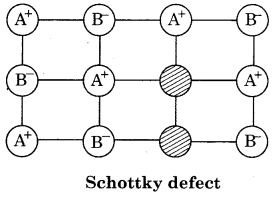
(ii) Frenkel defect:
If an ion is missing from its lattice site (causing a vacancy or a hole there) and it occupies the interstitial site, electrical neutrality as well as the stoichiometry of the compound are maintained then it is called Frenkel defect. It is also called dislocation defect because smaller ion is delocated from its normal site to an intestial site. Example: ZnS, AgBr and AgI etc.
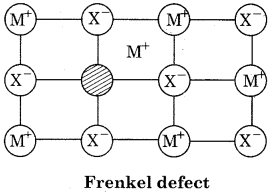
(iii) Interstitial Defect:
In this case, the extra anions may be occupying interstitial positions, The extra negative charge is balanced by the extra charges (oxidation of equal number of cations to higher oxidation states) on the adjacent metal ions. Such type of defect is not common because the negative ions are usually very large and they can not easily fit into the interstitial sites.
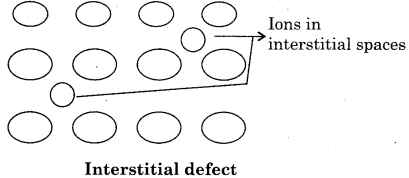
(iv) F-centre:
When a negative ion may be missing from its lattice site, leaving behind a hole which is occupied by an electron, to maintain electrical neutrallity. The site containing electrons thus trapped in the anion vacancies are called F-centers because they are responsible for imparting colour to crystal. (F= Farbe which is a German word for “colour’).
Examples :
Yellow colour of NaCl, pink colour of Lici, purple colour of KCl etc.
Question 13.
Explain the following with suitable examples
(i) Ferromagnetism
(ii) Paramagnetism
(iii) Ferrimagnetism
(iv) Antiferromagnetism
(v) 12-16 and 13-15 group compounds
(vi) Pyroelectricity
Answer:
(i) Ferromagnetism:
Substances which show permanent magnetism even in the absence of the magnetic field are called ferromagnetic substances .e.g. Fe, Ni, Co, Gd and CrO2. Such substances remain permanently magnetised once they have been magnetized. These substances are very strongly attracted by a magnetic field. In ferromagnetic substances magnetic moment is aligned in one direction.

(ii) Paramagnetism:
Substances which are attracted by the external magnetic field are called paramagnetic substances. The property thus exhibited is called paramagnetism. This property is shown by those substances whose atoms, ions or molecules contain unpaired electrons e.g., O2, Cu2+, Fe3+ and Cr3+ etc. These substances, however, lose their magnetism in the absence of the magnetic field.
(iii) Ferrimagnetism:
Substances which are expected to possess large magnetism on the basis of the magnetic moments of the domains but actually have small net magnetic moment are called ferromagnetic substances e.g. magnetite (Fe3O4).
(iv) Antiferromagnetism:
Substances which are expected to possess paramagnetism or ferromagnetism on the basis of magnetic moments of the domains but actually they possess zero net magnetic moment are called anti-ferromagnetic substances. e.g. MnO. Antiferromagnetism is due to the presence of equal number of domains in the opposite directions.

(v) 12–16 and 13-15 group compounds:
The compounds formed by the combination of the elements of group 12 – and group -16 are called 12–16 compound.
Examples: ZnS, HgTe, etc.
The compounds formed by the combination of the elements of group – 13 and group -15 are called 13–15 compounds.
Examples: Ga As, AIP etc.
(vi) Pyroelectricity Some pyroelectric substances, when heated produce a small electric current. The electricity thus produced is called pyroelectricity. where pyro means heat.